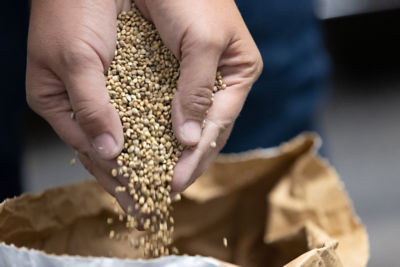Causal Agent
Pseudoperonospora cubensis
Distribution
Worldwide
Symptoms
Symptoms initially appear as small chlorotic lesions on older leaves, later appearing on the younger leaves. The margins of these lesions are generally irregular on most cucurbit species. However, on cucumber, lesion margins are defined by the leaf veins which give an angular appearance to the lesions. When leaf surfaces remain wet for extended periods, water-soaked lesions develop on the undersides of leaves. These lesions can appear similar to those caused by Pseudomonas syringae pv. lachrymans. In humid environments, sporangia form on the underside of leaves, giving the appearance of a whitish-gray to purple fine downy growth. Lesions eventually coalesce and become necrotic, but may continue to expand until the entire leaf dies. Severe infection results in defoliation, stunting of plants and poor fruit development.
 Water-soaked and necrotic lesions on the abaxial side of a cucumber leaf.
Water-soaked and necrotic lesions on the abaxial side of a cucumber leaf.
Conditions for Development
Survival of Pseudoperonospora cubensis between growing seasons is dependent on living cucurbit hosts. Sporangia may be transmitted considerable distances between fields by wind. Within fields sporangia are spread by air currents, splashing water, workers and/or equipment. Fog, dew and frequent rain favor disease development, which can be rapid when temperatures are moderate to warm. High temperatures [>35°C (>95°F)] are not favorable for disease development, but disease development may progress if night temperatures are cool [15–20°C (59–68°F)].
Control
Provide adequate spacing between plants to reduce canopy density. Grow varieties with genetic resistance to Pseudoperonospora cubensis. Implement a preventative fungicide spray program. Regional disease forecasting models have been used successfully to predict onset of symptoms and to time spray applications for effective control of Pseudoperonospora cubensis.



